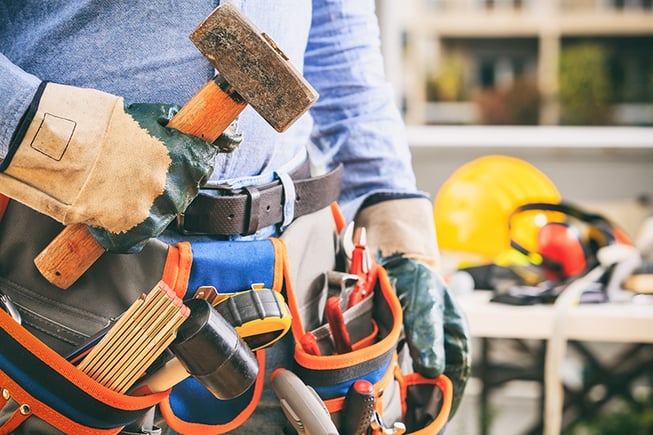
There is no doubt that a tool belt is one of the most important pieces of equipment in the workplace. It will often allow the user to easily access accessories such as two-way radios, measuring equipment, electrical devices and even units to measure the presence of hazardous gases. However, there are still a few drawbacks associated with the modern tool belt. Countless workers feel that they are overly burdened with equipment that may not be necessary. This can present a problem in the event that a health and safety supervisor is required to add yet another accessory to an overly jumbled belt. How can the number of lone worker safety devices be reduced to avoid the "Batman belt" syndrome while still ensuring that all employees remain protected throughout their shift?
The Power of Two-Way Communications
One of the best ways to free up space on an equipment belt is to employ a single device which provides two different purposes. It could be argued that the most common example here is a mobile phone which also serves as a two-way radio (these were very common in the 1990s). The main advantage here is that many businesses can download dedicated applications which can be used to function as a live person-to-person intercom. Not only will this approach save space, but the reception of 3G (and possibly 4G) technology is much more reliable when compared to ten years ago. There are even instances when the phone can be removed from the belt entirely and placed in a jacket pocket. It can be accessed in a matter of seconds and the employee will obviously feel less burdened.
Keeping Safety in Mind
There are many instances when workers may possibly be exposed to noxious gases such as ammonia, hydrogen cyanide or carbon monoxide. Even in the telecommunications industry, such hazards can sometimes occur (for example, when upgrading switches in the basement of a building used to produce petrochemical products). The risk of injury or death is very real in such environments. In the past, employees would have to rely upon rather clumsy devices and in the majority of cases, multiple units would be needed to detect concentrations of specific gases. This would require the worker to change their equipment frequently and some would forego such procedures altogether in order to save time (regardless of whether or not health and safety stated that it was absolutely necessary). It is best to search for innovative equipment that is able to detect a number of gases simultaneously. The company Honeywell is an example of such possibilities, as they currently supply an impressive selection of different detectors. In terms of lone worker safety devices, these are excellent options to consider.
Check-In Procedures at the Beginning of the Day
This is another suggestion that can be frequently overlooked. There are countless instances when workers will have redundant or irrelevant tools attached to their belts. It is a great idea to ask all employees to determine whether or not this equipment will be required for their specific tasks. If some items are not necessary, they should place them aside or return them to a specific station. If they will be required later in the day, they can always be accessed.
Centralised Portals
This is actually an extension of the strategy mentioned in the previous section. As opposed to asking employees to simply remove their tools, it could be a better idea to provide multiple copies of specific items. They can be placed in a centralised area that is easy to access. Thus, workers can choose the right equipment for the right task. However, it is important to mention here that these tools should be located in an area that will not cause time to be lost in terms of retrievals. Otherwise, efficiency may ultimately be sacrificed.
The One-Size Fits All Approach
Modern manufacturing methods have allowed many tools to be much more universal than in the past. Still, some workers fail to realise the benefits that these innovations have to offer. A perfect example can be seen in the streamlined nature of the common multi-tool. Cutting instruments, screwdrivers, miniature saws and wire strippers are often offered within a single package. Another massive benefit is that the tool can be folded up and tucked away when not in use.
This same concept is just as relevant for universal screwdrivers. Gone are the days when workers would be required to carry multiple varieties such as flat heads, Phillips heads and hexagonal heads. Many devices will now offer a selection of configurations stored in the handle. These are interchangeable and can be quickly mounted when required.
Another excellent example can be seen in a pair of locking pliers (the brand name Vice Grip is perhaps the most well-known version). These pliers can adjust to fit numerous dimensions. They are often able to replace stand-alone tools such as ratchets and wrenches. Another useful feature in regards to locking pliers is that they are available in different sizes. Therefore, smaller versions can be procured without taking up excess space on a tool belt.
The Space-Saving Edge
There are countless situations when saving space on a tool belt can come in "handy". In terms of lone worker safety devices and concerns, such a concept is especially relevant. The fact of the matter is that employees will be much more likely to adopt any recommendations imposed by health and safety teams if such suggestions are able to maximise their levels of comfort. Also, let us never forget that a simplified belt equates to greater levels of balance and mobility; a critical concern for anyone working at heights or without a supporting harness. These are some simple and yet effective recommendations that can take much of the guesswork out of tackling what may initially appear to be a rather daunting task.





